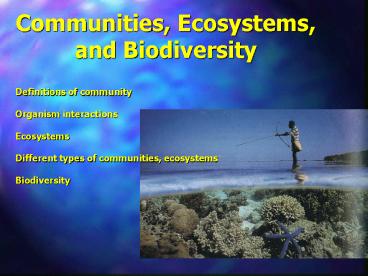Communities, Ecosystems, and Biodiversity - PowerPoint PPT Presentation
1 / 16
Title:
Communities, Ecosystems, and Biodiversity
Description:
Communities, Ecosystems, and Biodiversity Definitions of community Organism interactions Ecosystems Different types of communities, ecosystems Biodiversity – PowerPoint PPT presentation
Number of Views:202
Avg rating:3.0/5.0
Title: Communities, Ecosystems, and Biodiversity
1
Communities, Ecosystems, and Biodiversity
Definitions of community Organism
interactions Ecosystems Different types of
communities, ecosystems Biodiversity
2
Community Definitions
All organisms in an area Also includes
interactions, structure, organization Can also
include recurrence The biological component of
ecology (interactions between an organism in an
area plus the environment) Superorganism
(Clements, 1926) vs. Individualistic responses
(Gleason, 1929)
3
Organism Interactions
Competition Food, space, nutrients, light Niche
concept and guilds Dominance Organisms
partition resources so dont compete Dominant
organisms
4
Organism Interactions
Predation Hunting chemosensory, visual
predator avoidance Morphology, chemistry,
behavior Predators and trophic pyramids
5
Organism Interactions
Epibiosis relationships mutualists, parasites,
commensal Keystone species and species of great
effect
6
Why study marine communities?
Understand trophic web Recognize keystone
species, species of great effect Conservation
practices Fisheries impacts, sustainable
harvesting Importance of previously unknown
processes Microbial loop, primary productivity
and iron Understand impact of pollutants
7
Example Sea Grass Bed, TX
Annually dynamic, but over time, averages out to
similarity Dead versus live assemblage
comparisons In current near estuary, fully
marine
8
Example Sea Grass Bed, TX
Sea grass baffles sediment environment
mediator, species of great effect Clams,
gastropods, polychaete worms, arthropods,
others Larval settlement at different times of
year per species Clams in spring Summer many
dead juvenile clam shells in sediment Seagrass,
algae primary producers Gastropods grazers,
predators Clams detritovores Mussels and
polychaetes filter feed Arthropod and fish
predators Seagrass substrate for microbes, algae
Microbial loop recycles nutrients
9
ECOSYSTEM
Ecosystem community environment Scaless Envi
ronment physical aspects Topography, sediment
type, currents, light Often anthropogenic
effects pollutants, sediments Dynamic always
changing on fine temporal scales Over geologic
time slow and quick changes
10
Example Hydrothermal Vents
Deep ocean, near black smokers Very high T
water, sulfur, other chemicals No light, low
O2 Tube worms, bivalves, shrimp, crabs,
eels Symbiotic relationship with sulfur-fixing
bacteria Similar to photosynthesis, but some
predation Nutrient input from smokers,
detritus Organisms tightly coupled with
environment Open or closed system? Patches far
apart, smokers ltd time Organisms have to get
there somehow!
11
Biodiversity
Species richness how many species Can be
studied on community/ecosystem scale or
globally Ocean extremely diverse Reefs more
diverse than rainforest! Most of study of
biodiversity through time marine Diversity
greatest on continental shelves, coasts Light,
nutrients --gt primary productivity
high Diversity in deep ocean also
high Nutrients, O2 Butpatchy
12
Extinctions
Local extirpations --gt global extinctions Small,
background extinctions --gt mass
extinctions Background extinctions local to
regional one or few species Causes of
background extinction Speciation, outcompete,
invader, environment, disease
13
Mass Extinctions
Involve MANY species, global 5 major mass
extinctions Largest P/Tr, 250MYA 80 to 95
marine life Most well known K/T, 65MYA 40
marine life
14
Mass Extinctions
Causes of mass extinction Climate
change ocean circulation change Volcanism Ext
raterrestrial impact Sea-level change Human
factors
15
A human-caused mass extinction?
16
Trophic changes































